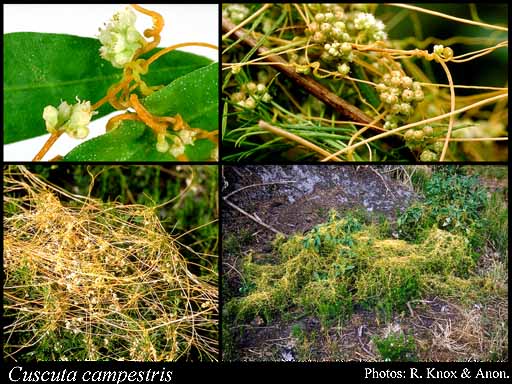- Reference
- Mem.Torrey Bot.Club 18:138 (1932)
- Conservation Code
- Not threatened
- Naturalised Status
- Alien to Western Australia
- Name Status
- Current
Parasitic, twining annual, herb or climber. Fl. white, Feb to Apr. Coastal heath and shrubland, river flats, disturbed areas.

Distribution
- IBRA Regions
- Central Ranges, Dampierland, Jarrah Forest, Swan Coastal Plain, Victoria Bonaparte, Warren.
- IBRA Subregions
- Keep, Mann-Musgrave Block, Perth, Pindanland, Southern Jarrah Forest, Warren.
- IMCRA Regions
- WA South Coast.
- Local Government Areas (LGAs)
- Albany, Broome, Bunbury, Denmark, Manjimup, Ngaanyatjarraku, Perth, Wyndham-East Kimberley.
Management Notes (for the Swan NRM Region)
General Biology. Growth form. Vine. Life form. Annual. Reproduction. Dispersed by wind, water, animals, and machinery and planting material contaminated by dodder seeds. Seed production is prolific with up to 1,600 seeds per plant. Seedbank persistence. Up to 50 years.
Notes. Annual, leafless, parasitic plant. Yellow, thread-like stems (up to 0.8 mm) that twine around its host plant. It lacks normal roots and leaves but does bear flowers and fruits. Seeds are viable and germinate readily but can only survive the seedling stage if they get a host immediately after germination..
Additional information. Origin. Native to North America and parts of the Caribbean. Similar exotic species. Cuscuta pentagona and Cuscuta tasmanica.
Suggested method of management and control. All host and dodder plant material must be burnt, preferably on the infested site. Cut the host plant as close as possible to ground level and burn it. Burning can be carried out after cutting and drying. Burning is more effective following the application of a desiccant herbicide. Metsulfuron-methyl 300 g/kg + Aminopyralid 375 g/kg (Stinger™) Rate: 2 g in 100 L of water Read the manufacturers' labels and material safety data sheets before using herbicides. For further information consult the Australian Pesticides and Veterinary Medicines Authority to determine the status of permits for your situation or state.
Management Calendar
| Calendar Type | Jan | Feb | Mar | Apr | May | Jun | Jul | Aug | Sep | Oct | Nov | Dec | Comments |
|---|---|---|---|---|---|---|---|---|---|---|---|---|---|
| Flowering | Y | Y | Y | Y | Y | Y | Y | Y | |||||
| Fruiting | Y | Y | Y | Y | Y | Y | Y | Y | |||||
| Germination | Y | Y | Y | Y | Y | Y | Y | ||||||
| Optimum Treatment | Y | Y | Y | Y | Y |
Legend: Y = Yes, regularly, O = Occasionally, U = Uncertain, referred by others but not confirmed.
References
- ().
- Agriculture Victoria (2017) Dodder. Victorian Government URL: http://agriculture.vic.gov.au/agriculture/pests-diseases-and-weeds/weeds/a-z-of-weeds/dodder - Accessed April 2019.
- BioNET-EAFRINET (2011) Cuscuta campestris. Taxonomy for Development East Africa URL: https://keys.lucidcentral.org/keys/v3/eafrinet/weeds/key/weeds/Media/Html/Cuscuta_campestris_(Golden_Dodder).htm - Accessed April 2019.
- NSW WeedWise (2018) Golden Dodder. Department of Primary Industries, NSW. URL: https://weeds.dpi.nsw.gov.au/Weeds/GoldenDodder - Accessed April 2019.